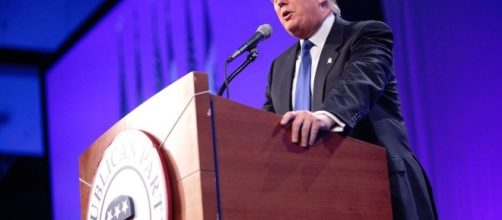With stories proliferating in the media that the Trump administration is prepared to send NASA on a course correction back to the moon, with a lunar orbital mission as early as 2020, the question arises, how to announce the new initiative? There is an art for rolling out new presidential initiatives, as this writer relates in his book “Why is it so Hard to Go Back to the moon.” A look back at history would be of some use.
President John F. Kennedy announced the Apollo race to the moon during a special joint session of Congress, acknowledging that the legislative body would have to pay for the program and giving it the highest priority.
Kennedy followed up the speech with an address at Rice Stadium in Houston.
President Ronald Reagan emulated Kennedy, a man he had much in common with politically and stylistically, during a State of the Union Address in 1984 when he proposed the project that eventually became the International Space Station.
President George H. W. Bush announced the space exploration Initiative in front of the National Air and Space Museum. When SEI ran into a wall in Congress, the elder Bush tried to do a Kennedy and made a follow up speech at Texas A&I University in Kingsville, Texas. His son, President George W. Bush. Proposed the Vision for Space Exploration at NASA headquarters and never mentioned it again.
Barack Obama went to the Kennedy Space Center to deliver the bad news that we were not going back to the moon after all.
President Trump is due to address a joint session of Congress on February 28. He is supposed to lay out his vision and agenda for America. The joint session would be a perfect occasion to roll out the return to the moon, with NASA partnering with commercial companies. The occasion will provide a high profile for the proposal. The comparisons to Kennedy and Reagan would not hurt either.
Of course, as this write describes in his book, the follow through is just as important as the big speech. Trump has to nurture the return to the moon relentlessly, on par with the Wall, repealing Obamacare, trade agreement renegotiations, immigration reform, and tax cuts.
One consideration is where and in what way should the president do the follow up speech. Following Bush the Elder and Kennedy’s example, it should be at a university.
Going to Rice would be a great idea and shameless in the way that only Trump would be able to pull off. The university has a perfectly serviceable stadium the president could use. A variety of people could provide the background to the speech, including astronauts, both current and past, NASA officials, commercial space CEOs, and students involved in STEM education, painstakingly selected for their ethnic diversity. Trump’s enemies will complain, claiming that he is no Kennedy. That accusation will be true, but irrelevant. If the president succeeds where both Bushes failed and gets America out beyond low Earth orbit permanently, he will become a greater historical figure than JFK ever was.

